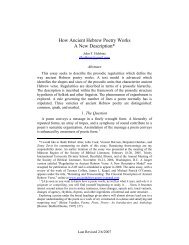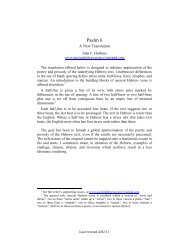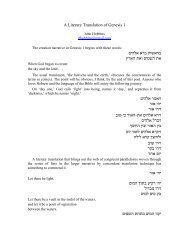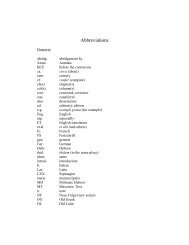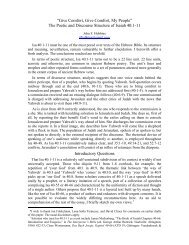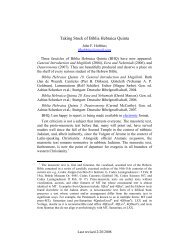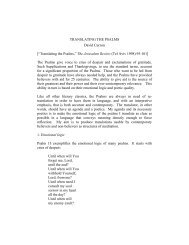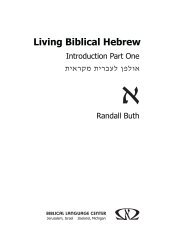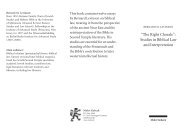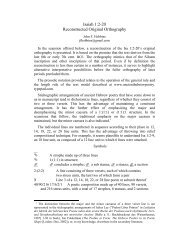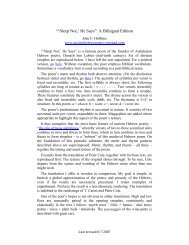Here - Ancient Hebrew Poetry - Typepad
Here - Ancient Hebrew Poetry - Typepad
Here - Ancient Hebrew Poetry - Typepad
- No tags were found...
You also want an ePaper? Increase the reach of your titles
YUMPU automatically turns print PDFs into web optimized ePapers that Google loves.
28according to a conventional order initiates a unit consisting withoutexception of 3 or (2:2) prosodic words. Units of 3 and (2:2), butapproximately equal in terms of syllable count, are the compositions’building blocks. The variation adds pleasantness to what would otherwise bea monotonous sequence. Syntactically, an acrostic unit corresponds to aclause – except when it doesn’t. Prosodic and syntactic asymmetries acrossunits of approximately equal phonological length make the poetry lesstedious. Adjacent acrostic units combine to form lines and strophes inaccordance with the general rule, but do so in unpredictable ways. 54Regularities beyond the System of Twos and Threes: The Length RuleOnce the lines of a poem are correctly identified, a length rule, that is, aset of regularities involving aggregate numbers of lines, is discernible:A poem, if it contains more than 10 lines, typically consists of 12, 18, 22, 28,or 36 lines, or combinations thereof. Among the Psalms, 14 lines is also acommon length.The rule delimits macro-units of poetry in terms of 12’s, 14’s, 18’s, 22’s,28’s, and 36’s. 55 Its validity cannot be demonstrated here. In conjunction54Pss 111-112 are composed in a kind of mashal meter in which half-lines ofapproximately equal syllabic length consist of 3 to 4 (not 2 to 4) prosodic words. See thewriter’s “Psalms 111-112,” online at: ancienthebrewpoetry.typepad.com.55 With respect to the number of lines a poem in ancient <strong>Hebrew</strong> typically has, I amindebted, if only indirectly, to Yehoshua Gitay (Prophecy and Persuasion: A Study of Isaiah40-48 [Forum Theologiae Linguisticae 14, Bonn: Linguistica Biblica, 1981]; “Reflectionson the Study of Prophetic Discourse: The Question of Isaiah I 2-20,” VT 33 [1983] 207-221;Isaiah and His Audience [Assen: Van Gorcum, 1991]). His insistence that we seek toidentify fully formed compositions in ancient prophetic literature, and not assume, as manydo, that all we have are snippets of prophetic discourse strung together and reworked for adifferent purpose by another hand, emboldened me early on to consider the possibilities.According to the length rule, larger compositions conform to strict conventions,confirmation of the correctness of David Noel Freedman’s intuition that large poeticstructures work within rigid constraints in terms of length (“Another Look at Biblical<strong>Hebrew</strong> <strong>Poetry</strong>,” in Directions in Biblical <strong>Hebrew</strong> <strong>Poetry</strong> (ed. Elaine R. Follis; JSOTSup 40;Sheffield: Sheffield Academic Press, 1987) 11-28; 26; repr. in Divine Commitment andHuman Obligation: Selected Writings of David Noel Freedman, Volume Two: <strong>Poetry</strong> andOrthography (ed. John R. Huddleston; Grand Rapids: Eerdmans, 1997) 213-226; 225). 22line poems were identified in non-acrostic contexts by, among others, R. B. Y. Scott(Proverbs-Ecclesiastes [AB 18; Garden City: Doubleday, 1965] 71 [Prov 2:1-22]; MitchellDahood (Psalms I: 1-50 [AB 16; Garden City: Doubleday, 1966] 234 [Ps 38]); David NoelFreedman (“Acrostic Poems in the <strong>Hebrew</strong> Bible: Alphabetic and Otherwise,” CBQ 48[1986] 408-31; repr. in Divine Commitment and Human Obligation: Selected Writings ofDavid Noel Freedman, Volume Two: <strong>Poetry</strong> and Orthography (ed. John R. Huddleston;Grand Rapids: Eerdmans, 1997) 183-204; 197-202 [Ps 33]); Delbert R. Hillers



